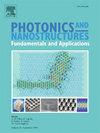Design of robust topological edge states clock-shaped multiplexer in anisotropic photonic crystals enhanced by neural networks
IF 2.5
3区 物理与天体物理
Q3 MATERIALS SCIENCE, MULTIDISCIPLINARY
Photonics and Nanostructures-Fundamentals and Applications
Pub Date : 2025-06-15
DOI:10.1016/j.photonics.2025.101423
引用次数: 0
Abstract
Topological edge states have demonstrated significant potential in controlling light propagation. This paper presents a high-degree anisotropic photonic crystal based on a combination of convolutional and fully connected neural networks. The model accurately predicts the asymmetry parameters and band structure in both directions. We achieve topological edge state transmission over a broader frequency range compared to traditional valley photonic crystal array channels. We precisely predict accurate results for both wide-frequency boundary state outputs and topological bandgaps. We design a clock-shaped wavelength division multiplexer to enable precise optical channel selection. Our deep learning model demonstrates robust performance against input variations, and the structure remains highly resilient to disturbances. The deep learning-assisted anisotropic structure demonstrates precise selectivity, wideband high-intensity transmission and strong robustness in topological edge states significantly enhancing the application potential and development efficiency of topological edge states.
神经网络增强各向异性光子晶体鲁棒拓扑边缘态时钟型多路复用器的设计
拓扑边缘态在控制光传播方面已经显示出巨大的潜力。本文提出了一种基于卷积神经网络和全连接神经网络相结合的高度各向异性光子晶体。该模型准确地预测了两个方向的不对称参数和能带结构。与传统的谷光子晶体阵列通道相比,我们在更宽的频率范围内实现了拓扑边缘状态传输。我们精确地预测了宽频边界态输出和拓扑带隙的准确结果。我们设计了一个时钟形波分复用器,以实现精确的光通道选择。我们的深度学习模型显示了对输入变化的鲁棒性能,并且结构对干扰保持高度弹性。深度学习辅助的各向异性结构在拓扑边缘态上具有精确的选择性、宽带高强度传输和较强的鲁棒性,显著提高了拓扑边缘态的应用潜力和开发效率。
本文章由计算机程序翻译,如有差异,请以英文原文为准。
求助全文
约1分钟内获得全文
求助全文
来源期刊
CiteScore
5.00
自引率
3.70%
发文量
77
审稿时长
62 days
期刊介绍:
This journal establishes a dedicated channel for physicists, material scientists, chemists, engineers and computer scientists who are interested in photonics and nanostructures, and especially in research related to photonic crystals, photonic band gaps and metamaterials. The Journal sheds light on the latest developments in this growing field of science that will see the emergence of faster telecommunications and ultimately computers that use light instead of electrons to connect components.

 求助内容:
求助内容: 应助结果提醒方式:
应助结果提醒方式:


